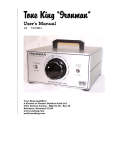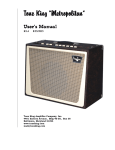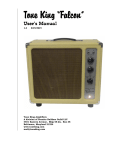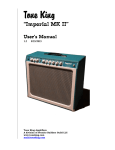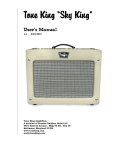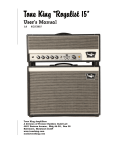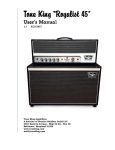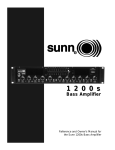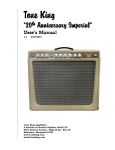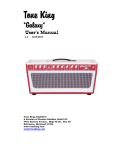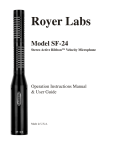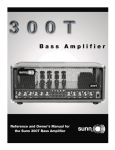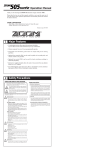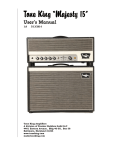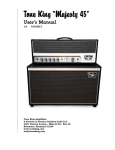Download the Falcon Grande User Manual
Transcript
Tone King Falcon Grande' User’s Manual 1.0 8/21/2015 Tone King Amplifiers A division of Premier Builders Guild LLC www.toneking.com [email protected] Design Notes from the Builder Thank you for choosing the Falcon Grande. My initial idea for the Grande was to simply address certain requests by Falcon owners - specifically, a 12" speaker, footswitchable voicings, and reverb. Although I started with these simple goals, the design process led to a number of new developments, resulting in complete redesign of the circuitry and cabinetry. To this end, the Grande is a genuine new design, sharing very little with the Falcon model, aside from it's basic shape and some of its' features. One interesting development is a proprietary variation of the ultralinear output stage which solves some of the inherent problems of the ultralinear circuit. The new design delivers the same fullbodied sound, thick mids, and sweet top end, but with perfectly controlled compression, and very low hum. No matter how hard you push this output stage, it will not become too compressed - just more harmonically rich. Another new feature I developed specifically for this model is the acoustic lens built into the speaker cabinet. This device eliminates high frequency beaming (the "icepick effect" - whereby the high frequencies become excessively exaggerated and harsh at certain listening positions). The advantage of this new design is that it eliminates beaming without muddying the sound or slurring the attack, as standard beam blockers and foam doughnuts do. It gives you a lively, present sound without harsh beaming, anywhere in the room. The last development I'll mention is the new reverb circuit. I had been using essentially the same reverb circuit for all Tone King amps up to this point, and thought that this new model warranted something special. I developed a new 2 knob circuit that is more flexible than the older circuit, in that allows a wide range of dwell settings, from a subtle shimmer to a splashy surf sound. In addition, I developed a new receiver circuit which is extremely transparent and capable of extracting more detail and overtones from the reverb pan than the old design, but it also has the warmth, depth, and organic qualities to make it a perfect match for a vintage style amp like the Grande. In the end, I think the Falcon Grande turned out to be a terrific new model, packed with innovation and new developments that make it really fun to play, with a wide range of fantastic tones that sound great in any room or environment. I hope you enjoy playing it as much as I do. Mark Bartel Tone King Amplifiers a division of Premier Builders Guild LLC 1 Safety Instructions 1. Please read these instructions, and keep them for reference. 2. Please follow all instructions described here. 3. Do not use this apparatus near water. 4. Clean only with a dry cloth. 5. Do not block any ventilation openings. 6. Do not operate near any heat sources such as radiators or heat registers. 7. Protect the power cord from being walked on or pinched, particularly at the plugs and at the point where they exit from the apparatus. 8. Only use attachments/accessories specified by the manufacturer. 9. Unplug this apparatus during lightning storms or when unused for long periods of time. 10. Refer all servicing to qualified service personnel. Servicing is required when the apparatus has been damaged in any way. For example, if the power supply cord or plug is damaged, liquid has been spilled or objects have fallen into the apparatus, the apparatus has been exposed to rain or moisture, does not operate normally, or has been dropped. 11. CAUTION: To disconnect the unit completely from the MAINS, unplug the unit. Turning the power switch off does not disconnect the unit completely from the MAINS. 2 Contents 1. Specifications 4 2. Front Panel Controls Guitar Inputs Volume and Tone Voicing Selection Reverb Controls 5 5 5 6 6 3. Back Panel Controls AC Power Fuse Power Switch, Standby Switch Footswitch Speaker Jack Attenuation Control 7 7 7 7 7 7 7 4. Dialing In Your Sound Rhythm Voicing Tweed Voicing Lead Voicing 8 8 9 10 5. Ironman/II Attenuator Purpose of the Attenuator Attenuator Control How to Use The Attenuator Technical Details 11 11 11 12 12 6. Getting a Great Sound at Home The Effect of Your Acoustical Environment Floor Reflections Where to Place the Amp Carpeting The Attenuator Can Help 13 13 13 13 13 14 7. Tube Installation and Replacement Choice of Tube Types and Brands Alternate Tube Choices Installing Tubes Replacing Output Tubes Tube Quality 15 15 15 16 16 16 8. Warranty 17 9. CE Declaration 18 3 1. Specifications Preamplifier Channels: Tube Complement Controls: Single Channel with footswitchable Voicing Control 2 x 12AX7 Volume, Tone, Voicing (Rhythm, Tweed, Lead) Reverb Type Controls: Footswitch: Full size 2-spring reverb pan Dwell (drive level), Reverb (recovery / mix level) Footswitch control of reverb (on/off) Power Amplifier Output Power Tube Type Biasing Scheme Operating Mode 20W R.M.S. 2x5881, push-pull (2x6L6 may be used) Cathode Biasing Modified Ultralinear Speaker Manufacturer Impedance Magnet Type Edge Doping 12" Custom designed speaker made by Eminence 8 Ohms Ceramic, 38oz Non-Doped Power Attenuator Type Load Type Attenuation Steps: Compensation: Speaker Interface: Ironman II Compensated Power Attenuator Tuned Reactive Load 6 Steps: 0db, -3db, -9db, -15db, -24db, -36db Fletcher-Munson Volume Compensation Circuitry Damping Factor Correction Footswitch Type Functions: 4-Button Footswitch with L.E.D. Indicators Voicing Selection, Reverb on/off Dimensions 21.5" W x 19" T x 11" D Weight 34lbs 4 2. Front Panel Panel Controls Guitar Inputs The Falcon Grande has two separate guitar inputs - HI and LO. The HI input has more gain, and the LO input has less gain. One obvious use of these two inputs is to compensate for the output level of your guitar pickups. For example, you might want to use the LO input for humbucking pickups, and the HI input for single coils. However, there is another, less obvious effect related to the choice of HI or LO input. If you switch from the HI to LO input, the balance of gain among the preamp stages is altered, which results in some tonal changes in addition to the reduction in gain. Using the LO input will give you a fatter, thicker midrange, and a softer, sweeter top end. Using the HI input will give you more clarity and detail, and a sharper attack. You might want to experiment with both HI and LO inputs at each Voicing setting to experience the tonal differences they provide. Volume and Tone It's quite easy to dial in a great tone with the Falcon Grande, because of the minimal set of preamp controls. The Volume control determines the gain of the preamp, and thus the volume level of the amplifier. The Tone control adjusts the balance of high frequencies to low frequencies, allowing some broad tonal shaping. These two controls are slightly interactive, meaning that the effect of the Tone control is slightly different at different Volume control settings. You can think of them as operating in more or less the same way as the Volume and Tone controls of many classic vintage amps, such as the tweed deluxe. 5 Voicing Selection The Voicing switch allows you to select between three very distinct preamp voicings, and is the key to the Falcon Grande's tonal versatility. As you toggle between voicing selections, one of three completely separate and distinct tone shaping preamp circuits is switched into the signal path, to transform the overall character of the tone. You can select the Voicing in two ways: 1. Front Panel Voicing Switch When the footswitch is disconnected from the amplifier, the front panel Voicing switch controls the voicing selection. 2. Footswitch When the footswitch is connected to the amplifier (the footswitch jack is located on the rear panel), the front panel Voicing switch becomes inactive, and the Voicing can only be selected by the footswitch. Reverb Controls The Falcon Grande's reverb circuit is an all-new design that offers more depth, more flexibility, and an enhanced ability to extract subtle details from the full-size spring reverb pan which generates the effect. The circuit includes both Dwell and Mix (Reverb) controls, and the use of each should be understood in order to dial in the best possible reverb sound. Dwell Control The Dwell control determines the level of the signal driving the spring reverb pan. In general, this control can be thought of as controlling the "character" of the reverb sound. As you turn up the dwell control, a more powerful driving signal is sent to the reverb pan, which affects the sound of the reverb in several ways: - at lower Dwell settings, the reverb is darker sounding, and more subtle. - at higher Dwell settings, the reverb sound is brighter and 'splashier', and you begin to hear more 'flutter', more overtones, and more of the the unique characteristics of the spring reverb pan. Reverb (Mix) Control The Reverb (Mix) control determines the amount of reverb signal from the reverb pan that is mixed with the dry signal. This is the same function performed by the "Reverb" knob on most amplifiers that have a single knob reverb circuit (e.g. deluxe reverb). In general, this control can be thought of as controlling the "amount" of reverb you hear. NOTE ! Turning both the Dwell and Mix controls up all the way will result in an overthe-top, surf guitar kind of reverb sound, with a lot of brash overtones and a long reverb tail. This extreme setting is intended for special purpose uses, where an overthe-top, out-of-control kind of reverb sound is desired as a special effect. It's not intended for general use. 6 3. Back Panel Controls AC Power Always use a grounded AC cord, and make sure that a proper ground connection is supplied to the amp. Never attempt to lift or defeat the ground connection to the amp. Fuse A standard 2A slo-blo fuse (style 3AG) should be used. Power Switch, Standby Switch When powering up the amp, you should start with both the Power and Standby switches in the "off" position. First, turn on the Power switch. This will apply power only to the tube filaments and the low-voltage circuitry. After turning on the Power switch, allow the tubes to warm up for about 1 minute, then turn on the Standby switch. The power-down sequence is not as important as the power-up sequence, though I generally prefer to turn off the power switch while leaving the standby switch in the ON position. Footswitch Connect the footswitch to the amp with the supplied cable, or with any standard 4-prong XLR cable. When the footswitch is connected to the amp, the Voicing switch on the front panel will become inactive, so voicing selection can only be done with the footswitch. Speaker Jack The Falcon Grande has a single speaker with an impedance of 8 Ohms. The speaker jack is located on the side of the chassis, and is a standard 1/4" jack. If you wish to use an extension speaker, it’s best to use an 8-ohm speaker. You can connect it with a standard ¼” mono speaker cable by pulling out the plug from the internal speaker, and plugging the cable into the speaker jack. Attenutation Control The Attenuation control determines the amount of attenuation applied to the output of the amplifier in order to reduce the amount of power sent to the speaker, and thus control the volume of the amp. The use of the attenuator will be described in detail in a following section. 7 4. Dialing in Your Sound Rhythm Voicing The Rhythm voicing is designed to deliver a fatter, warmer version of the classic mid60's clean tone, with a smoother, less spiky top end. This is a nice lush clean tone that retains the sonic characteristics of the amplifiers that inspired it, such as the mid-60s Deluxe Reverb. Here are a few sample settings you may want to try: 1. 60's Clean Rhythm Tone Guitar/ Pickups Single Coil Input Volume Tone Reverb Dwell HI 4 4 5 5 Humbucker LO 5 6 5 5 Input Volume Tone Reverb Dwell LO 7 4 5 5 Guitar/ Pickups Single Coil Input Volume Tone Reverb Dwell HI 6.5 7.5 5 5 Humbucker HI 5 7.5 5 5 Input Volume Tone Reverb Dwell HI 7.5 8 7 9 2. Extra-Fat Clean Rhythm Tone Guitar/ Pickups Single Coil 3. Pushed Clean 4. Surf Reverb Guitar/ Pickups Single Coil 8 Tweed Voicing The Tweed voicing is inspired by vintage classics like the Tweed Deluxe, Tweed Bassman, and others of the period. This is very versatile voicing. At lower volume settings, the clean tone is thick and warm, with a nice presence in the midrange and a silky top end. This makes it great for fattening up a tele, or even for an authentic 50's jazz sound with a hollowbody guitar. As you crank up the volume, the power tubes add some growl and subtle compression, which you can control with your pick attack and playing style, for an expressive sound like you might hear on the Steely Dan records of the 70s. Crank it up, and you'll get the milkshake-thick grind that tweed amps are known for. Here are a few sample settings: 1. Fat Clean Tone Guitar/ Pickups Single Coil Input Volume Tone Reverb Dwell HI 3 3 4 4 Humbucker LO 4 4 4 4 Guitar/ Pickups Single Coil Input Volume Tone Reverb Dwell HI 5 5 3 3 Humbucker HI 4 7 3 3 2. Edge of Overdrive 2. Hot Tweed Crunch Guitar/ Pickups Single Coil Input Volume Tone Reverb Dwell HI 8 5 3 3 Humbucker HI 8 6 3 3 9 Lead Voicing The Lead voicing adds a little Valco/Supro mojo to the basic Tweed sound, for a unique and authentic old-school guitar tone. If you plug into the LO gain input, and keep the volume control down relatively low, this setting conjures the sound of early blues and rock & roll with a rounded, boxy, semi-clean tone that captures that distinctive character found on recordings from the '50s by artists such as Chuck Berry, Bill Haley, etc. If you plug into the HI gain input, and crank it up, the amp really comes alive. This voicing gives you plenty of gain for a nice chunky hot-tweed lead sound, while the unique 5881 output stage helps prevent it from becoming too compressed, fizzy, or buzzy, no matter how hard you drive it. Even with single coils, you can dial in a nice thick crunch like you might hear on the old ZZ Top records. 1. 1950's Rock & Roll Guitar/ Pickups Single Coil Input Volume Tone Reverb Dwell LO 6 4 3 3 Humbucker HI 5 4 3 3 Guitar/ Pickups Single Coil Input Volume Tone Reverb Dwell HI 9 5 5 2 Humbucker HI 8 7 5 2 2. Crunchy Lead 10 5. Ironman/II Attenuator Purpose of the Attenuator In the Falcon Grande, virtually all overdrive and distortion are generated by the phase inverter and output tubes. Output stage distortion has a different sound and feel than distortion generated in the preamplifier, and this is big part of the Falcon Grande's unique tone. The difficulty with this type of design is that overdrive and distortion can only be achieved at maximum output power (and therefore maximum volume). Operating the amp at maximum volume isn't practical for all playing conditions, so a power attenuator is an effective and necessary solution to control the volume level while allowing the output tubes to operate at full output power. A power attenuator is a circuit which is connected between the output of the power amplifier and the speaker. It allows you to selectively send some fraction of the power generated by the output tubes to the speaker, with the rest dissipated in a built-in load circuit, as shown in the diagram below: Attenuator Control On the Attenuation dial, 0db is the loudest setting. At this setting, the attenuator is fully bypassed, and the speaker is connected directly to the output of the amplifier. The –36db setting is the quietest setting. At this setting, most of the power generated by the output tubes is absorbed by the attenuator's load circuit, and only a few dozen milliwatts of power are sent to the speaker. 11 How to Use the Attenuator First, lets start with the basics of how to use the attenuator. For practical purposes, the Attenuation knob can be thought of as providing the same function as a “master volume” control. This means that you will use the “Volume” controls to adjust the gain of the preamp and the amount of overdrive/distortion you wish to dial in, and you will use the “Attenuation” dial to set the volume level that you wish to produce. You may wish to experiment to confirm this behavior. For example, try selecting the lead voicing, and set the amp up like this: Volume Tone Voicing Reverb Dwell 7 7 Lead 4 5 Attenuation -24db Now, while playing through the amp, try turning the Volume control up and down a bit. You will see how slight changes in the Volume control will make the tone more or less distorted, but won’t have much effect on the volume level in the room. The reason for this is that the output stage of the amplifier is already generating maximum output power even if the amp is only just on the edge of breakup. As you turn up the Volume control past this point, the output stage cannot produce any more power – it just becomes more overdriven. After trying that experiment, set the volume control back to 7, where you started, and try adjusting the attenuation knob on the back of the amp. You will see that the volume level in the room changes, but the amount of overdrive and distortion does not. This is the purpose of the attenuator. Technical Details The Falcon Grande's Ironman II attenuator is a fairly sophisticated unit containing certain features that make it very effective at maintaining the cranked amp sound at even very low volume. Here are few technical details of these design features: Tuned Reactive Load To preserve the natural response and feel of an amplifier, it is critical that the output tubes see the proper loading. The Tuned Reactive Load of the Ironman-II closely mirrors the impedance curve of a real speaker, which results in a more natural tone and feel than the simple resistive load used in most attenuators. Volume Compensation Circuitry The ear perceives sound differently at low and high volume levels, which is why many attenuators may sound thin and muffled at lower settings. The Ironman-II overcomes this phenomenon with its' proprietary Volume Level Compensation Circuitry, which adjusts the tonal balance at each attenuation step, to ensure that the sound you hear is always as deep, rich, and present at low volume as it is at high volume. Damping Factor Correction A loudspeaker performs differently when driven with very little power, compared to its response at full power. The Ironman-II's Damping Factor Correction Circuitry compensates for this effect, making the speaker perform more naturally at low volume so it retains the feel of a cranked amp, even at bedroom volume. 12 4. Getting a Great Sound at Home The Effect of Your Acoustical Environment When playing in a large room or on a big stage, getting a great sound from your amp is easy. Generally, in this type of setting, you would simply crank the amp up to full power, and it would sound great. Playing at home, or in any small room, is a different story. In a case like this, the acoustic properties of the room can have a big influence on the sound you hear, and can often cause problems. There are many types of problems that can happen in a small room. Here are a few suggestions for how to deal with them: Floor Reflections If you have the amp sitting on a hardwood, tile, or concrete floor in a small room, it may sound harsh in the upper midrange, because of reflections off the floor directly in front of the amp. To help solve this problem, you might try placing a small piece of carpet (or a doormat, for example), directly in front of the amp. Where to Place the Amp To begin, it should be noted that the Falcon Grande was designed to be placed on the floor, and it will have the best tonal balance sitting directly on the floor. However, due to certain design features of the speaker cabinet, it can also sound very good when elevated, but it may lose some bass extension. Next, you will find that the sound you hear is greatly influenced by the location of the amp in the room, and by the orientation of the amp with respect to the listening position (i.e. if the amp is pointing at you or away from you). I strongly suggest experimenting by moving the amp around to different places in the room, playing through it at each location, to find the place that sounds the best. Carpeting Carpeting can cause problems as well, and it’s not quite as simple as rolling off the high frequencies and making the amp sound dark. Often, the problem is that it causes a dip in a certain region in the midrange, leaving a hole in the lower midrange that makes the amp sound harsh and brittle in the top end. This generally can’t be helped by moving the amp to a different location in the room. The only solution I’ve found is to raise the amp up a few inches off the floor. You may lose some bottom end in doing this, but the positive effect in smoothing the midrange response will more than make up for it. 13 The Attenuator Can Help So far, we’ve discussed using the attenuator to control the volume in the case where we’re driving the amp into overdrive and distortion. However, it can also help with clean tones in a problematic room as well. Usually, in a good sounding room, you would set the attenuation knob to 0db or bypass the attenuator when dialing in a clean tone. This always gives you the most headroom, and the most apparent clarity and dynamics. However, if you are finding that the amp sounds harsh in your room, and that it’s hard to control the volume because you are using a setting between 1 and 2 on the Volume knob, then the attenuator can help. Try setting the attenuator down a few steps (e.g. try it at –15db), plug into the LO input, and turn the Volume control up a bit to compensate. You should find that this smoothes out the upper mids and fattens up the tone without losing presence. 14 5. Tube Installation and Replacement Choice of Tube Types and Brands The following tube types are recommended: No. Type and Brand V1 TAD 12AX7A-C/Tung-Sol 12AX7A V2 TAD12AX7A-C/Tung Sol 12AX7A V3-V4 Tung Sol 5881 Function Preamplifier Phase Inverter Output Tubes The tube brands shown above are my own preferences. You may want to use other brands, to tailor the sound to your own tastes. Here are a few notes on the various brands available today: Output Tube Choices: Choices The Falcon Grande is designed to accept 5881 output tubes. Of the brands available today, my preference is the Tung Sol 5881. You may also install 6L6s in the Falcon Grande. 6L6s are a drop-in replacement, with no adjustments necessary. In the Falcon Grande, 6L6s will have a bit later breakup, but may be a bit glaring in the top end. 12AX7 Tubes: Tubes Both the TAD 12AX7A-C, and the Tung Sol 12AX7A are a great match for the Falcon Grande. Both have a nice balance of detail and warmth, with the Tung Sol having perhaps a bit more transparency in the top end, and the TAD having a bit less glassiness but still a nice presence in the upper mids. EH 12AX7s are very similar to Tung Sol 12AX7s – both are very quiet with very low microphonics and are a bit on the bright side, with an extended top end. Tung Sols seem a bit warmer than EHs. The Svetlana 12AX7, a short-plate tube, has nearly the clarity of the 12AX7EH, and slightly more bottom end, but is a bit congested in the midrange. Years ago, I had selected this brand as the brand of choice for the Meteor/II amp, but later changed to a combination of the 12AX7EH and the 12AX7LPS. Sovtek 12AX7LPS – this long-plate 12AX7 has a big, warm sound that comes close to a good NOS long-plate 12AX7. However, this tube can tend to be microphonic. Alternate Tube Tube Choices You May Want to Try If the preamp is too gainy for your taste, and you find that you’re setting the volume controls down quite low to get sufficient clean headroom, you may want to try swapping in either a 12AU7 or 5751 in the V1 position. 15 Installing Tubes When installing tubes, you may find it helpful to lay the amp on its side, on a table, and shine a light directly into the back of the amp, to aid in locating the position of each tube. Tubes must be installed in the correct orientation. The 12AX7 tubes have a blank space in the ring of pins which must line up with the blank space in the ring of pins in the tube socket, located on the chassis. The 5881 tubes have a small cylinder with an indexing key in the center of the ring of tube pins, and this indexing key must match up with the corresponding slot in the socket on the chassis. Replacing Output Tubes The output stage of the Falcon Grande is cathode biased, and no bias adjustment is necessary when changing output tubes. The design of the Falcon Grande’s output stage allows a fair amount of margin for variation in tube characteristics, so any known brand of 5881 or 6L6 will work properly and be correctly self-biased. Tube Quality Currently manufactured tubes are built in China, Russia, or the Czech Republic, and are not built to the same quality standards as tubes manufactures by the U.S. manufacturers in the “glory days” of tube manufacturing. We musicians choose to use to vacuum tubes because of their tone, but we need to accept that the tubes available to us these days can be imperfect devices, and are most certainly the least reliable component in the entire amplifier. It would seem that the obvious solution would be to use new-old-stock tubes that were made back in the “glory days”, when tubes were properly made. However, I’ve lately been finding that much of the available stocks of such “new old stock” tubes are either gassy, noisy, or unreliable – I do believe that we’ve reached the bottom of the barrel of NOS tubes. Tube problems generally reveal themselves as a crackling noise which can occur continuously, sporadically, in response to mechanical vibration, or in response to your playing (e.g. a crackling or other type of noise which occurs only when you hit a note). We subject all tubes to a thorough burn-in and test procedure to ensure that they are fully up to spec and operating perfectly. However, you must be aware that the majority of tube failures occur early in their life, and may come about as a result of the jostling and jarring that an amp can receive in shipping. In spite of the exhaustive testing we perform at the shop, early-life tube problems cannot always be found in such testing. The first two months or so are the most tenuous period for any set of tubes. Most manufacturing defects will be revealed in the first two months of their life, but many are not detectable in initial testing, even after a burn-in period. If you notice any noises, cracking, or any other odd behavior of your amplifier in this period, note that it is most likely to be the result of a defective tube, and should be debugged as such. 16 Premier Builders Guild LLC Limited Warranty Premier Builders Guild LLC 201 S. Highland Avenue, Suite 204 Pittsburgh, PA 15206 This warranty gives you specific legal rights; you may also have other rights which vary from state to state. There are no express warranties except those listed below. Length of Warranty This warranty shall remain in effect for five years from the date of sale of the product as shown on the original bill of sale. What is Covered This warranty covers all defects in material and workmanship in this product, with the following exceptions: 1. Damage or deterioration of the cabinet, or any other cosmetic damage which occurs after delivery is not covered by this warranty. 2. Damage after initial delivery resulting from accident, unreasonable use, or neglect, is not covered by this warranty. 3. Damage resulting from the performance of repairs by someone other than the Tone King Amplifier Company is not covered by this warranty. 4. Damage occurring during shipment or delivery of this product to the Tone King Amplifier Company after initial delivery of the product is not covered by this warranty. 5. Vacuum tubes are considered a user-replaceable item, as they are expected to wear out and require replacement over a reasonable period of time. Tubes are warranted to be serviceable for a period of 90 days from the date of sale. 6. The speaker(s) in this amplifier has(have) been selected for use only with this amplifier. If the speaker(s) of this amplifier is(are) connected to an amplifier other than the intended amplifier, any warranty of this speaker shall be deemed void. What We Will Pay For The Tone King Amplifier Company will pay for all labor and material expenses to fix or replace all items covered under this warranty. The customer will pay shipping charges to return the product to the Tone King Amplifier Company. If the necessary repairs are covered under this warranty, the Tone King Amplifier Company will pay any shipping charges required to return the product to the customer. Limitation of Implied Warranties All express or implied warranties of merchantability and fitness for a particular purpose are limited in duration to the length of this warranty, unless otherwise provided by state law. Exclusion of Certain Damages The Tone King Amplifier Company’s liability is limited to the repair or replacement, at our option, of any defective product, and shall in no event include incidental or consequential damages of any kind. Some states do not allow limitations on the length of an implied warranty and/or do not allow the exclusion of incidental or consequential damages, so the above limitations and exclusions may not apply to you. Obtaining Warranty Service If your unit requires service, it should be returned to the Tone King Amplifier Company at the address listed above. Before returning the unit, you must contact the Tone King Amplifier Company and obtain return authorization. 17 CE Declaration 18



















